Coachcraft 1940 Ford
COACHCRAFT 1940 FORD
In 1940 Coachcraft LTD created what must be one of the first full custom 1940 Fords for Clarence Salomon. The beautiful Convertible would later be owned by well known cinematographer James Wong Howe.
In the spring of 1940 four partners, Rudy Stoessel, Paul Erdos, Charlie Ratzenberger and Burton K. Chalmers formed Coachcraft Ltd. Together with a number of Darrin skilled craftsmen they opened a shop on Melrose Avenue in West Hollywood. One of their first cars they created was a 1940 Ford convertible “Coupe”. Clarence Salomon commissioned a custom convertible based on a 39-40 FoMoCo product from Coachcraft. Coachcraft designed a car based on a 1939 Mercury that would incorporate original fenders, and a newly shaped main body with, elegantly shaped V-windshield and a teardrop shaped padded top.
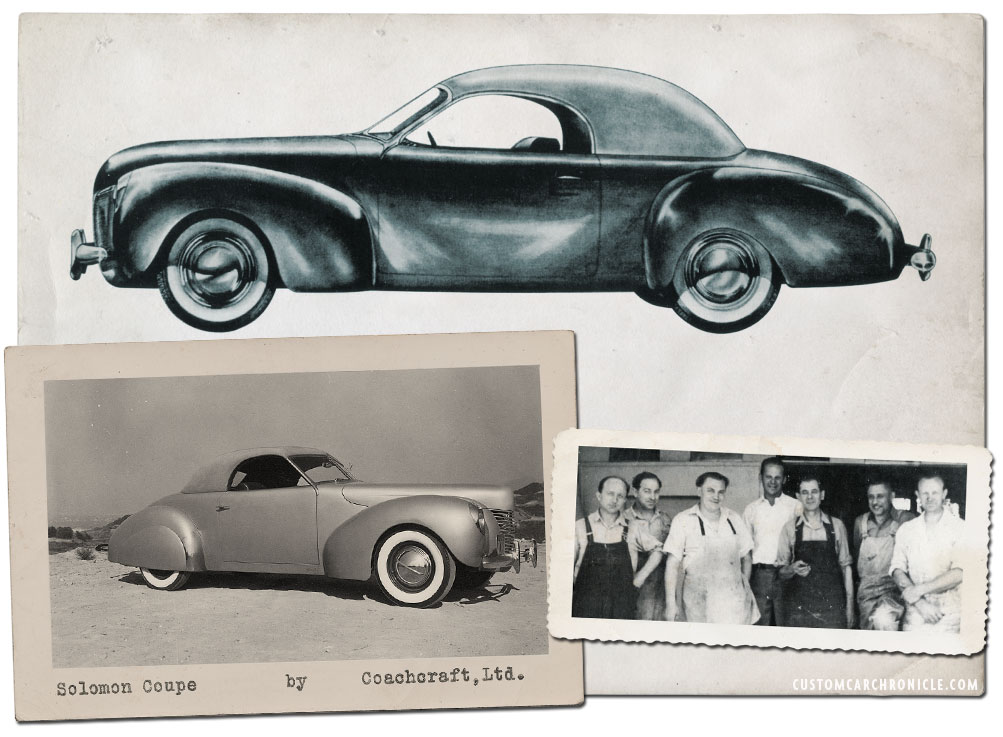 The original design sketch for the Solomon “Coupe” seamed to have been based on an 1939 Mercury judging the shape of the fenders. The inset photos show the Coachcraft promotional photo of the finished Coupe, and the team of craftsman at the Shop during the time the car was built.
The original design sketch for the Solomon “Coupe” seamed to have been based on an 1939 Mercury judging the shape of the fenders. The inset photos show the Coachcraft promotional photo of the finished Coupe, and the team of craftsman at the Shop during the time the car was built.
[divider]
The actual car was built based on a 1940 Ford, it is not known why they choose a Ford over the Mercury from the original design sketch. But to be able to maintain some of the dimensions of the original sketch, it was needed to stretch the 1940 Ford front fenders. The rear fenders of the 1940 Ford were used as they were, an are shaped differently from the original design. The main body was hand shaped over a wooden buck, and placed lower than stock over the frame, the Ford running boards were eliminated. The hand shaped main body reassembles the original Ford body, only being much cleaner with no belt line, or belt line trim added.
The rear of the body was also changed from the original design, and now flows nicely with the more teardrop shaped Ford rear fenders. When the new main body was designed the cowl was extend over stock specs. This allowed the cockpit to be further to the rear, and the hood to look longer for a much more powerful appearance. The Ford side grilles (louvered panels) were removed and replaced with shaped sheet metal. A new hand made grille was created from round rod, with far less bars than the original Ford unit. The finished grille was smothed and send out for chrome plating.
 The Solomon convertible during the final stages of the built at the Coachcraft shop in 1940.
The Solomon convertible during the final stages of the built at the Coachcraft shop in 1940.
[divider]
 At this stage the car was painted (possibly silver?), had black wall tires with ripple disk hubcaps, the side grilles were filled in, but the center grille is still the stock 1940 Ford grille unit.
At this stage the car was painted (possibly silver?), had black wall tires with ripple disk hubcaps, the side grilles were filled in, but the center grille is still the stock 1940 Ford grille unit.
[divider]
The original hood from the Ford was used, but to be able to make it work with the new lower main body it needed to be sectioned, and the belt line needed to be removed from it. Ruddy Stoessel and crew designed a new V-shaped windshield, they created patterns from the design and had it cast in bronze. The bronze windshield frame was cleaned up and send out to be chrome plated. The crew next created a hand shaped metal top to flow nicely front the angled back V-windshield. The new top was designed to be shorter than a stock 1940 Ford coupe top, have a much larger than stock rear window (which helped improve the rear view while driving) and no rear side windows. The finished top was padded and covered in a off-white canvas.
 We assume that these photos were taken during the final assembly of the car.
We assume that these photos were taken during the final assembly of the car.
[divider]
 It appears that the car is sitting on some large wooden blocks to be able to work on the suspension.
It appears that the car is sitting on some large wooden blocks to be able to work on the suspension.
[divider]
The top of the new doors where made ready to house a roll down side window glass with surround. The surround was shaped from U-channel to fit the windshield and teardrop shape of the side window opening. The car was made to be functional so it was also made completely weather proof. Most photo do not show the beautifully shaped window frame, but fortunately the owner of the car from 1955 to 58 took some pictures with the frames up. (check them out in Part 2)
The stock Ford taillights were removed, the holes filled in and a set of 1939-40 Packard taillights adapted to fit the Ford fenders. At the front the stock headlights were used. A set of teardrop shape bubble fender skirts was installed and a set of stainless steel rock shields mounted on the extended down (where the running boards used to adapt to) front of the rear fenders. A set of 1940 Lincoln bumpers was installed. The center section of the front bumper fits the custom grille really beautiful. The stock 1940 Ford door handles were installed on the home made doors, and with all the body work done the body was painted. It is said the car was painted a silver gray when it was first finished.
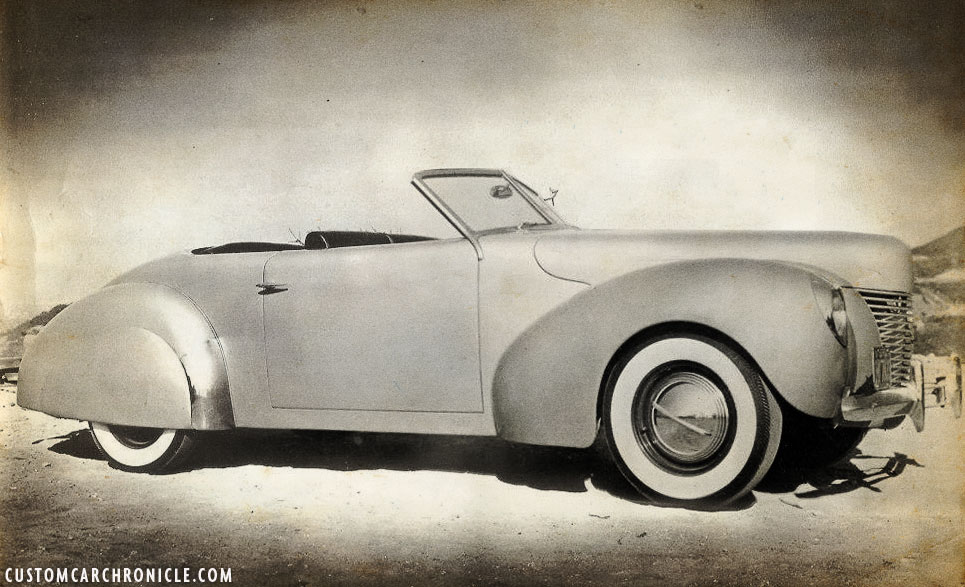 Even though the car was designed with the removable padded top, it also looked stunning with the top removed. The raised and stretched (14 inch) front fenders, sectioned hood and removal of the running boars made the car a lot sleeker.
Even though the car was designed with the removable padded top, it also looked stunning with the top removed. The raised and stretched (14 inch) front fenders, sectioned hood and removal of the running boars made the car a lot sleeker.
[divider]
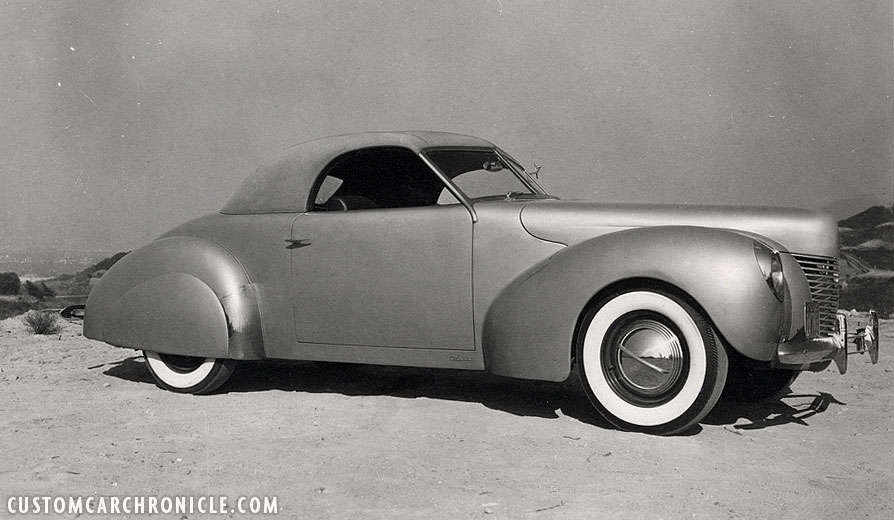 The first version for Clarence Salomon was finished in a light metallic color, most likely silver. The car had wide white wall tires, ripple disk single bar flipper hubcaps on dark colored wheels (no beauty rings) and tear drop skirts.
The first version for Clarence Salomon was finished in a light metallic color, most likely silver. The car had wide white wall tires, ripple disk single bar flipper hubcaps on dark colored wheels (no beauty rings) and tear drop skirts.
[divider]
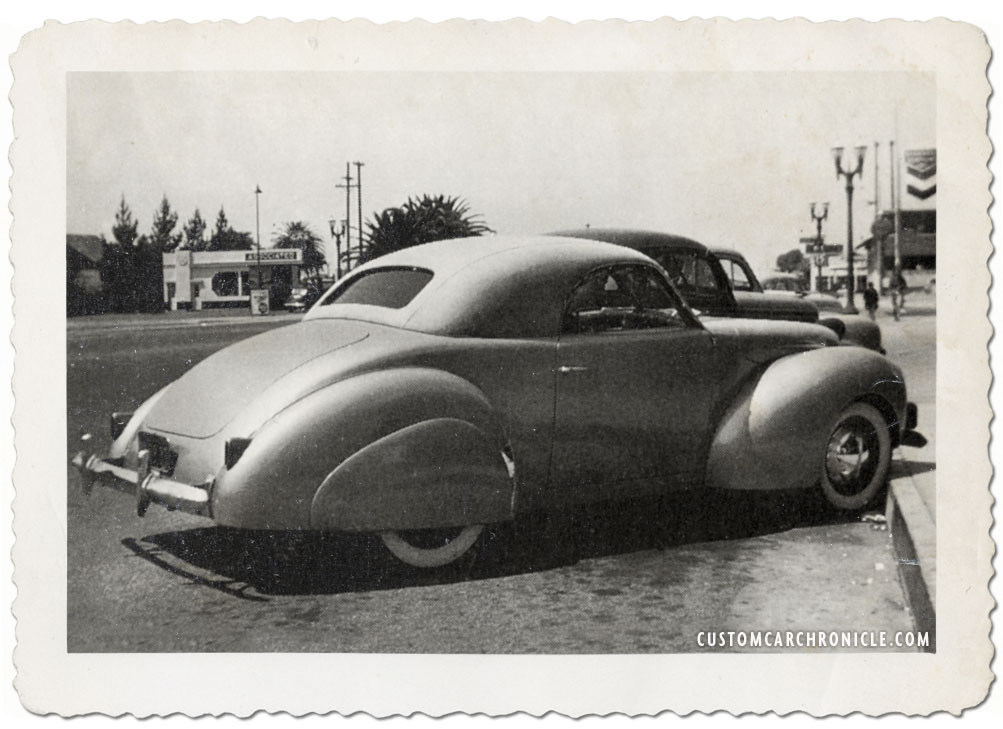 This and the front shot below are only known photos of the cars first version taking part of every day traffic. It must have been quite a sight to see such a well designed car on the streets of Los Angeles in the early 1940’s.
This and the front shot below are only known photos of the cars first version taking part of every day traffic. It must have been quite a sight to see such a well designed car on the streets of Los Angeles in the early 1940’s.
[divider]
A set of wide white wall tires was installed on dark colored wheel and a set of ripple disk single bar flipper hubcaps was used for dress up. The interior uses a stock 1940 Dash, column and steering wheel. There is an additional roll on top of the dash to optically extend the cowl inside the car. The car was upholstered in alligator and regular leather with tuck & roll panels on the doors.
The 1940 Coachcraft built Ford is an really interesting car in the history of the Custom Car. Coachcraft employees all had an history as coachbuilders, but especially the early creations from this shop, including this ’40 Ford had a more what we consider Custom feel to them. Especially the “lower end” based car and the general custom restyling elements make these early Coachcraft cars more Custom, than Coachbuilt.
Second version
We know that Clarence Salomon, who commissioned Coachcraft to built the car, later sold it to James Wong Howe, a well known Hollywood cinematographer. But we do not know what year James bough the car. We do know that James really loved the car’s looks and how it handled, and he used it as his daily transportation for several years. We assume the car was bought by James Wong Howe in the mid 1940’s. James Wong Howe’s name has since then been conected to the car, and the Ford is best known as the Wong Howe Coachraft Ford. The first photos after the original light colored and fender skirted version of the car from the early 1950’s are from 1951. The Revs Institute recently added a series of very nice photos of this 1951 version of the car to their online-collection. And these photo really give us a good look how beautiful this car really was.
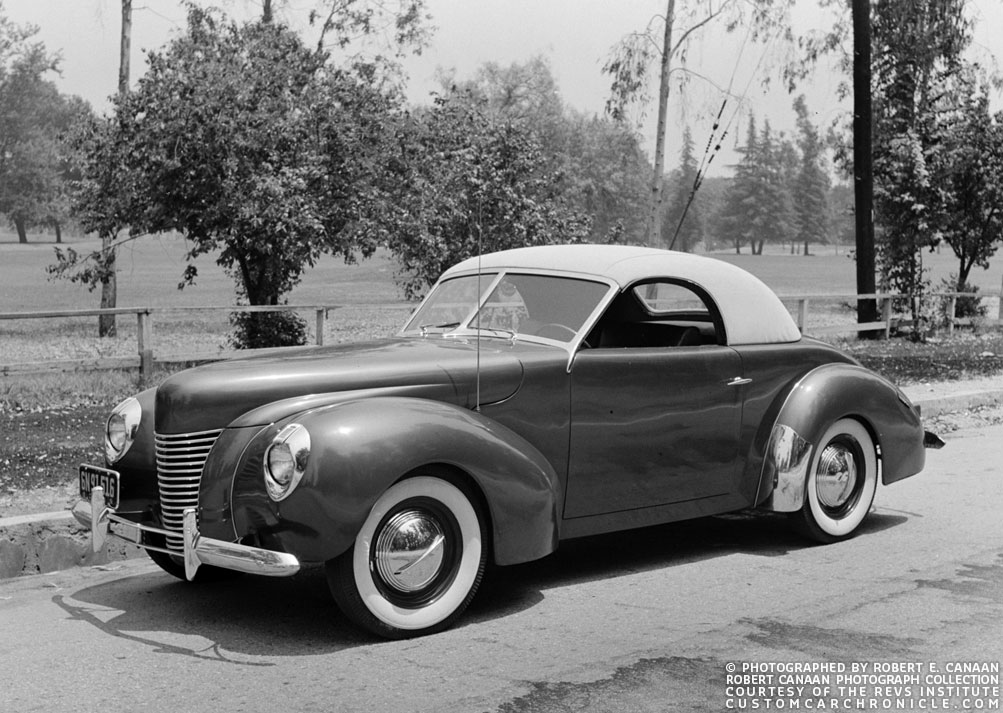 The car was now repainted in a darker color, possibly dark, or medium green and the fender skirts were removed. These changes gave the car a more sportive look.
The car was now repainted in a darker color, possibly dark, or medium green and the fender skirts were removed. These changes gave the car a more sportive look.
[divider]
By now the car had changed a little. Not to much though, but the skirts are now gone, and the car has been painted a darker color. We also do not know for sure what the color was, but when the car was bought by J.W. Tidmore from Texas in 1955 the car was painted a dark green. So perhaps the car was this same dark green when the photos of it were taken in 1951 by Robert E. Canaan. These photos, or some of them were also used in the September 1951 issue of Hop Up Magazine. The magazine shows four photos of the car, plus one on the cover, but does not list the owner name, nor color of the car. It is reported that the car had 100.000 miles on it when James sold the car in 1952 to David Crane from Texas.
 This rear quarter view shows the new smaller than stock trunk opening with no handle. The small slight teardrop shaped 39-40 Packard taillights are the perfect choice for the car. This view also gives us a good look at the large rear window opening on the removable top.
This rear quarter view shows the new smaller than stock trunk opening with no handle. The small slight teardrop shaped 39-40 Packard taillights are the perfect choice for the car. This view also gives us a good look at the large rear window opening on the removable top.
[divider]
 Side view shows the beautiful well balanced proportions of the car. Particularry nice is the the round shaped top and how the side window flow from the angled back windshield. The hight of the top is perhaps more Coachbuilt than Custom. The main body has some Cord design influences with its plain sides and large radius on the belt-line. Notice the gas door in the rear fender.
Side view shows the beautiful well balanced proportions of the car. Particularry nice is the the round shaped top and how the side window flow from the angled back windshield. The hight of the top is perhaps more Coachbuilt than Custom. The main body has some Cord design influences with its plain sides and large radius on the belt-line. Notice the gas door in the rear fender.
[divider]
 Close up of the beautiful designed and crafted grille and solid grille side panels. These side panels were hand made, but would later become available to the public from several aftermarket companies.
Close up of the beautiful designed and crafted grille and solid grille side panels. These side panels were hand made, but would later become available to the public from several aftermarket companies.
[divider]
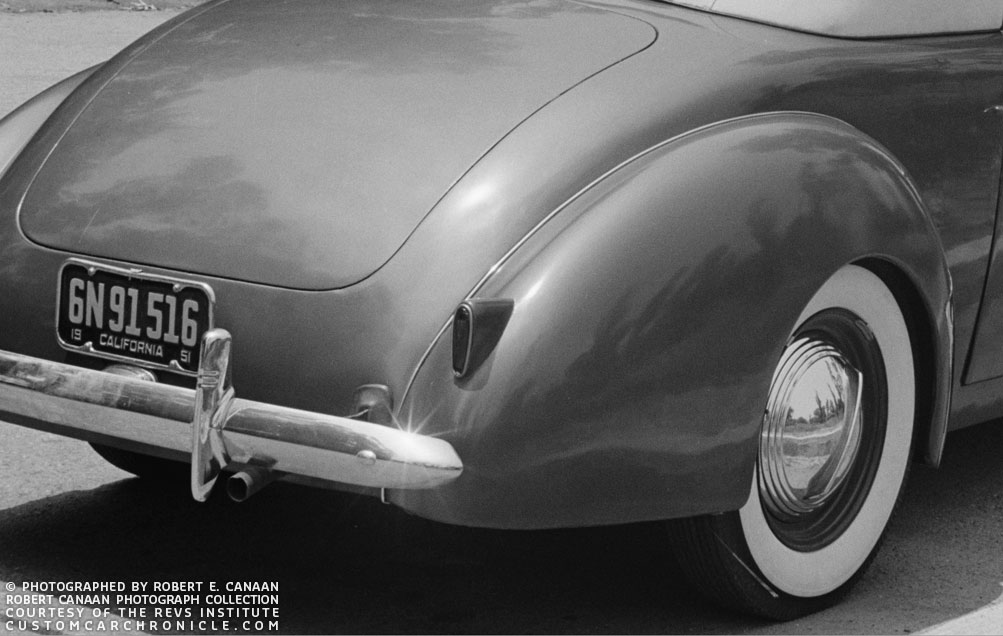 A closer look at the rear shows the elegant Packard taillights, the Lincoln bumper, the flowing lines of the trunk and the curb feeler for protection.
A closer look at the rear shows the elegant Packard taillights, the Lincoln bumper, the flowing lines of the trunk and the curb feeler for protection.
[divider]
 A lower angle look into the interior highlights the beauty of the windshield frame, the crocodile leather details and the roll above the dash that flows into the top portion of the doors, similar some roadster body styling.
A lower angle look into the interior highlights the beauty of the windshield frame, the crocodile leather details and the roll above the dash that flows into the top portion of the doors, similar some roadster body styling.
[divider]
 A view at the passenger side of the interior, notice the Coachcraft script on the rocker panel towards the cowl.
A view at the passenger side of the interior, notice the Coachcraft script on the rocker panel towards the cowl.
[divider]
 There was also a full seat in the rear that was upholstered similar to the front seat. Notice the weathering strip around the top window opening. The rolled down side window glass was fitting flush against it in the up position.
There was also a full seat in the rear that was upholstered similar to the front seat. Notice the weathering strip around the top window opening. The rolled down side window glass was fitting flush against it in the up position.
[divider]
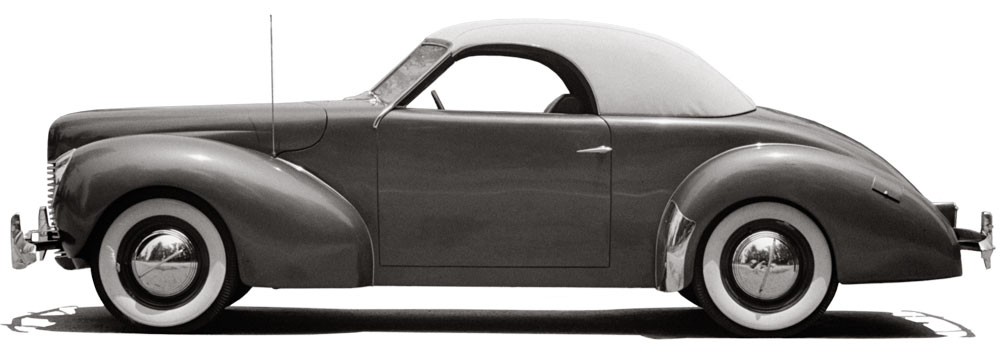
When J.W. Tidmore bought the car in 1955, it was equipped with a flat head Cadillac engine. Probably from a 1948 model with a Cadillac standard shift transmission.He was told that that engine was actually the third engine that was installed in the car since new. We have no idea if the engine in the car was original when it as first built, or what was in the car when the 1951 photos were taken.
Fortunately the Coachcraft 40 Ford is still around today, and even though it has been Hot Rodded to a certain extend, it is really great the car is still around, and in good shape. Read more about about what happened with the car after it was sold in 1955 in part TWO, or find out how the car looks after it was bought and redone by Tex Myers, to a version how it still looks in 2016 in part THREE
(This article is made possible by)
![]()




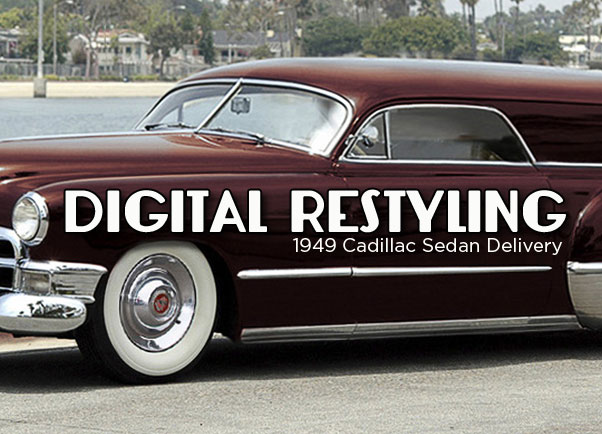


These early photos are true artifacts of history! And all of the crew at Coachcraft. Wonder what other quality custom coachwork came out of their shop? Rik, you keep expanding our horizons beyond Barris. There was a real rolling art movement going on back then, nearly everywhere. Thank you.
This car is amazing , at first glance it looks like a modified -40 Ford but that it is in large a full coach built body I didn’t know from the first time I saw pictures of it , also I didn’t know the company was started with this car as its first project .
The influence from Lincoln with high positioned front fenders and sectioned hood makes it look sleak , that together with the Lincoln bumpers makes it looks fantastic .
The general body has a lot of “custom” features , possibly inspire later custom car builders as for sectioned hood , moved up front fenders , shaved body , channeled body , to use luxury car parts on a base brand car , the list of “custom” mods that this car inspire are long and they were not modifications on this car since it was scratch built . To see this and also see the many similarities to Jimmy Goode:s -41 Cadillac Fleetwood based convertible with the scratch built body and clean sleak lines seems to be the Coach Craft trademark .
As usual big thanks for this in depth article of the obscure twilight land between custom and coachbuilt cars . one wish of unlimited funds and eternal life to build icon cars like this !!
Wolf
Fabulous car and great in depth article, thanks! I agree with most of what you are saying Wolf. Edsel and his team did basically the same modifications on a Zephyr when they created the Continental in -39 which probably made a huge impact on the coachbuilders and customizers of the time.
Incredible design….love the pictures in this article!